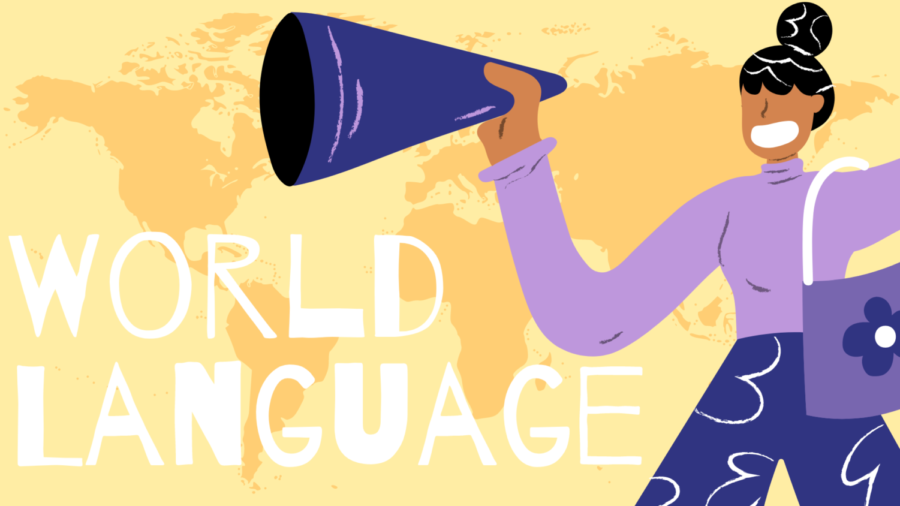The language of compassion
World language classes deserve more recognition
World language classes are offered to students in high school to improve upon skills that can greatly impact their futures. However, it’s the schools’ responsibility to better promote these classes and encourage students to consider just how important they can be. An increase in understanding and empathy for different cultures and regions could greatly benefit future generations.
March 26, 2021
One of the key building blocks our schools hope to instill within students is compassion for different cultures and religions. In every social studies class and English course, students are asked to critically analyze and consider a culture that is sometimes drastically different then what they’ve previously experienced. However, the best way to truly experience these cultures is through studying the language in which they speak. World language classes should be more heavily advertised to students in high school because the effects can be incredibly positive.
As of right now, foreign language classes are encouraged to incoming freshmen with little explanation and passion aside from the claim that it looks good on college applications. Although this selling point is by no means wrong, it doesn’t amplify the true benefits these classes offer outside of a basic understanding of the language. It’s unfair to lay the burden of advertising and explaining the importance of these classes on the world language teachers who are already tasked with planning and preparing lessons for the classes and clubs they lead.
Millard currently only offers Spanish classes to their middle school students. Originally, three languages were offered, but the district eliminated both French and German. Limiting the world language classes that students are able to partake in seems damaging to the purpose of the courses. By allowing students the opportunity to pick the language and culture they have the most interest in, it can be assumed that there will be more drive to continue along that path.
American journalist Flora Lewis describes the experience as “Learning another language is not only learning different words for the same things but learning another way to think about things.” This statement may have been said simply because Lewis had a passion for learning world languages but the concept has factual standing. According to the American Council on the Teaching of Foreign Languages, the study of a second language has been linked to enhanced problem-solving skills, improved verbal abilities, improved memory function (long and short-term), enhanced creative thinking and an improved attitude toward the target language and culture.
In a country, which is referred to as a mixing pot of cultures, the amount of citizens who can speak, read and comprehend a second language is embarrassingly low. The U.S. Census Bureau states that although 65 million U.S. residents speak a language other than English at home, that number only represents 20.7% of the total population. In areas like Europe, where the geographical distance between countries is greatly minimized, studying language in school becomes a national mandate. This encouraged effort to become aware of the cultural differences of the neighboring countries can only lead to a more empathetic relationship. According to the Pew Research Center, 73% of primary school and more than nine out of ten secondary students in Europe, study English. We can’t expect these countries to cater to us by learning our language and our culture without committing to learning their language and culture.
With the advancement of technology, learning another language has become easier and more accessible. Apps like Duolingo and Rosetta Stone make learning extremely flexible for the user and offer an extensive collection of different parts of both written and spoken language. Of course, we can’t expect students to take time out of their already hectic schedules without allowing time for restoration and relaxation. This is why it is massively important that world language classes in school are promoted more heavily to students.
The point of school is to prepare students to become working parts of society that can contribute to the success of our country. Speaking languages other than English can provide a larger scope into social and legal services that can be provided for an ever-changing and intermixing population. The Smithsonian Magazine published an article titled “The changing demographics of America,” which explained that “2050 will look different from that of today: whites will no longer be in the majority. The U.S. minority population, currently 30 percent, is expected to exceed 50 percent before 2050. No other advanced, populous country will see such diversity.”
The article goes on to say that immigration will continue to be a major factor in the makeup of U.S. life: “Latino and Asian populations are expected to nearly triple, and the children of immigrants will become more prominent.” But this isn’t an idea that should surprise the Americans of today. Historically, we have been a nation that has offered opportunities that allow anyone the chance to improve their lives and the lives of their families. When welcoming these new citizens, we should strive to understand where they come from through learning their language and culture, instead of assuming they will drop their traditions and history.
This is something that world language so easily provides to the students and teachers that take the time to study and understand it. The ability not only improves upon skills that will enhance your everyday life but also breeds compassion and empathy towards others. The recognition these classes and teachers get does not showcase the actual benefit students get by enrolling in these courses.
In a world that is so easily divided, being able to understand one another on a deeper level through the study of a language and culture should be more widely promoted. High school is the time in a young adult’s life where acknowledgment of other cultures can shape the way in which we work with others in the future. It’s the school’s responsibility to encourage its student population to enroll and continue taking the foreign language classes they offer.







